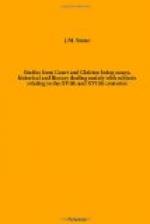The first regular catalogue of the Cottonian library was made and printed at Oxford by Dr. Thomas Smith in 1696. This catalogue is defective in many ways, especially as regards State Papers and detached tracts, of which there are no fewer than 170 volumes, which are here severally entered under one head only, although they each contain on an average as many as a hundred separate documents on different subjects. Dugdale, who was allowed to make what use he liked of the library, discovered 80 of these volumes in loose bundles, and had them bound. But they were still practically useless for want of proper descriptions and indices, till Planta, keeper of the MSS. in the British Museum, published his descriptive catalogue in 1802. Although not without faults, it has never been superseded.
It is to the third baronet that we are mainly indebted for the magnificent project of bequeathing the Cottonian library to the nation. He died in 1702, before the final steps had been taken in this direction; but his grandson and immediate successor carried out his wishes which had also been those of his father and grandfather.
The statute, drawn up in the year 1700 (12 and 13 William iii.) is entitled, “An Act for the better settling and preserving the library kept in the house at Westminster, called Cotton House, in the name and family of the Cottons for the benefit of the public.”
The next step was to have the books carefully inspected, and compared with Smith’s catalogue, now found to be inadequate. Many of the manuscripts were reported to be in a state of decay, the place where they were kept not being suitable. In 1706, Sir Christopher Wren was commissioned to fit up the study for public use, but he declared that Cotton House was in a ruinous condition; and in consequence of his report, in the following year, another Act of Parliament decreed that to increase the public utility of the library, Cotton House should be purchased of Sir John Cotton for 4500 pounds, and a new building erected for the collection of books. Still, nothing was done, till the house, actually threatening to tumble down, the books were removed to Essex House, in the Strand, where they remained for twenty-eight years. In 1730, Ashburnham House, Westminster, was purchased by the nation for the reception of the Cottonian, together with the Royal library. It was here, in 1731, that the terrible fire broke out in which so many valuable manuscripts were destroyed.
At about 2 o’clock in the morning of the 23rd October, Dr. Bentley, the librarian, and his family, who lived at Ashburnham House, were roused from sleep by a suffocating smoke which soon afterwards burst into flames. The outbreak was caused by a wooden mantelpiece taking fire, in the room immediately under the two libraries. It was at first hoped that the flames might be extinguished by throwing water upon the woodwork of the room actually on fire, so that they did not begin to remove the books as soon




